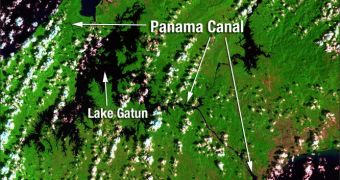A geological study of fault lines around the Panama Canal shows that the entire area may be at risk of being struck by a powerful earthquakes. One of the two fault lines in the new research is located directly underneath the Canal.
Panama City, the country's capital, will also be exposed to the effects of the devastation if a powerful tremor strikes in the area. But damages to the canal would cripple the economy, both in Panama and in other countries that depend on it for transporting merchandise from the Atlantic to the Pacific oceans and vice-versa.
In the new investigation, geologists determined that the fault lines in the area are capable of intense and powerful ruptures. The finding comes as the canal is being rebuilt, so that it can accommodate the passing of the world's largest cargo ships.
Work on the improvements is scheduled to be completed in 2014, which would coincide with the Panama Canal's 100th anniversary.
The passageway is being reconstructed because some three quarters of all cargo ships used today cannot pass through its narrow sections.
The research was commissioned by authorities that are in charge of the construction efforts. Engineers need to know what kind of risks the area is subjected to, in order to be able to build strong structures that would withstand tremors.
The canal itself is built right at the intersection of two very large tectonic plates, the Central American and South American plates. These massive landmasses are steadily driving into each other, building up pressure in the fault lines.
After analyzing historical records, geologists have concluded that the two plates have remained dormant for centuries, even if the country was hit by earthquakes in the past. This means that a lot of energy is stored within the area.
“I think to some degree we were all surprised that these faults were as active as they are,” explains the lead author of the new investigation, San Diego State University geology professor Thomas K. Rockwell.
Records also show that the last time the Pedro Miguel fault ruptured was back in 1621. This is the fault line that passes directly underneath the canal.
In the recent study, experts showed that the historic road Camino de Cruces was displaced by more than 9 feet from its original position following the 1621 earthquake.
Rockwell says that fault line does not pass directly under any of the locks that make up the canal. If an earthquake were to originate directly underneath the locks, then the amount of damage done to the structures would be immense.
But the expert remains reserved in making predictions about when a tremor could strike the area. “On the Pedro Miguel fault, we've had three large earthquakes in the last 1,600 years,” he says.
“The last earthquake was in 1621, so it's been almost 400 years,” he adds for Our Amazing Planet.

 14 DAY TRIAL //
14 DAY TRIAL //